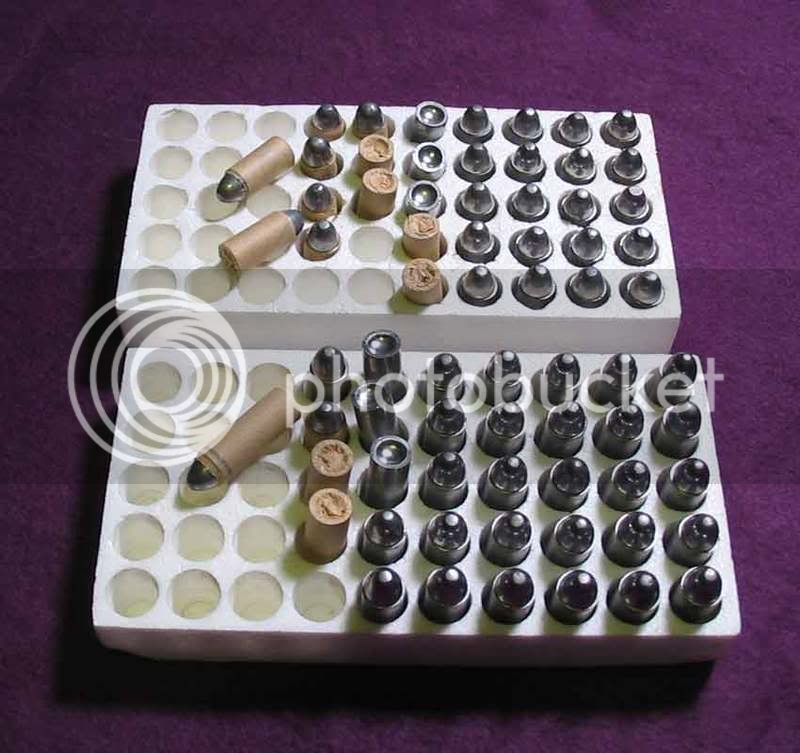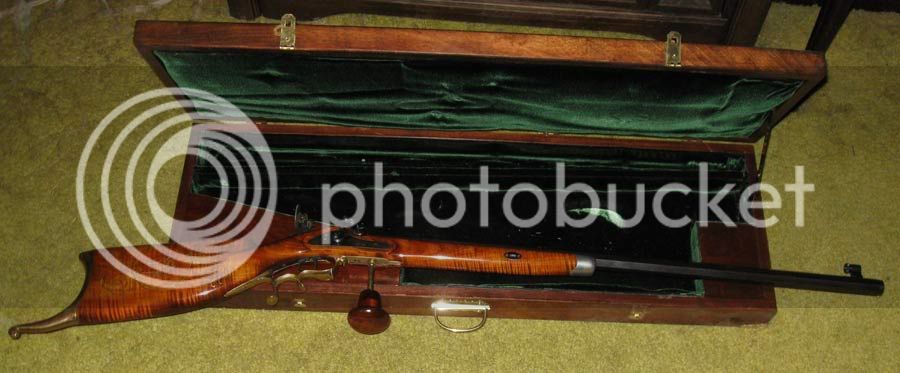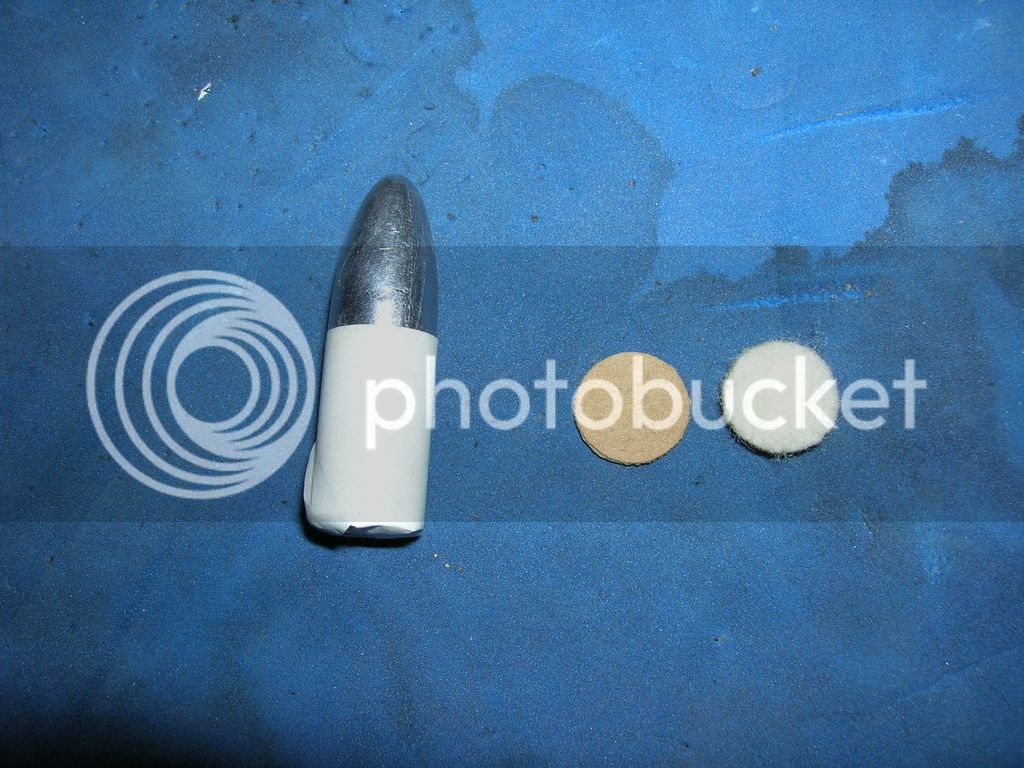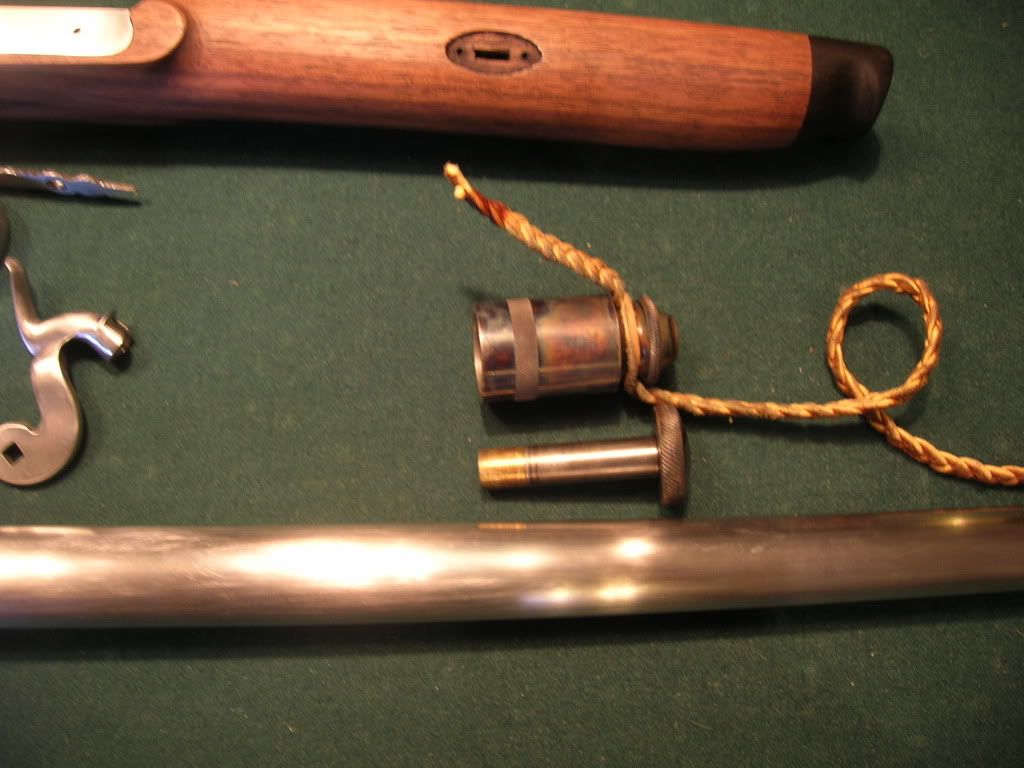I have been toying around with the idea of building a target rifle. I am considering having a custom barrel made. Does anyone have any suggestions on what rate of twist and rifleing depth should be for, say a 45 cal paper patched bullet. This barrel would most likely have a false muzzle. I am looking for some suggestions also for a good barrel maker reference. Thanks in advance for your ideas.
-
This community needs YOUR help today. We rely 100% on Supporting Memberships to fund our efforts. With the ever increasing fees of everything, we need help. We need more Supporting Members, today. Please invest back into this community. I will ship a few decals too in addition to all the account perks you get.

Sign up here: https://www.muzzleloadingforum.com/account/upgrades -
Friends, our 2nd Amendment rights are always under attack and the NRA has been a constant for decades in helping fight that fight.
We have partnered with the NRA to offer you a discount on membership and Muzzleloading Forum gets a small percentage too of each membership, so you are supporting both the NRA and us.
Use this link to sign up please; https://membership.nra.org/recruiters/join/XR045103
You are using an out of date browser. It may not display this or other websites correctly.
You should upgrade or use an alternative browser.
You should upgrade or use an alternative browser.
Target barrel
- Thread starter D Sanders
- Start date

Help Support Muzzleloading Forum:
This site may earn a commission from merchant affiliate
links, including eBay, Amazon, and others.
ohio ramrod
75 Cal.
- Joined
- Aug 21, 2008
- Messages
- 7,473
- Reaction score
- 2,202
Bobby Hoyt is the best custom barrel maker (in my opinion). Go with his advice! :idunno:
Ok, you have a good idea.
But your not going to "create" anything that hasn't already been done.
Fine barrels, proper twist rates, and excellent accuracy is already available for any and all imaginable calibers and bullet's that are man made.
The true accuracy is the shooter that is willing to take the time to consider, evaluate and control all of the variables that come with Black powder muzzle loading rifles.
But your not going to "create" anything that hasn't already been done.
Fine barrels, proper twist rates, and excellent accuracy is already available for any and all imaginable calibers and bullet's that are man made.
The true accuracy is the shooter that is willing to take the time to consider, evaluate and control all of the variables that come with Black powder muzzle loading rifles.
Col. Batguano
75 Cal.
- Joined
- Feb 10, 2011
- Messages
- 5,034
- Reaction score
- 1,406
The bullet weight, range and contemplated load / velocities will also be a part of the equation.
As an example, pistol barrels are generally rifled with a faster twist than rifle barrels. Why? Because the velocities are slower, so the rifling has to be faster to put the same rpms on the ball to stabilize it.
As an example, pistol barrels are generally rifled with a faster twist than rifle barrels. Why? Because the velocities are slower, so the rifling has to be faster to put the same rpms on the ball to stabilize it.
The barrel on the Schuetzen I made from a Pecatonica River "kit" came with a .40 caliber barrel made by Phil Quaglino.
He quit building barrels years ago but I'm sure there are other barrel makers who could make similar barrels.
The barrel as I said, is .400 caliber.
It has a 1:18 twist and the rifling grooves are .0015 deep.
It shoots both 330 and 400 grain paper patched, cup based slugs which I bought from Montana Precision Swaging in Butte, Mt.
These slugs do not have any grease grooves.
They are wrapped in two turns of .0015 thick dress pattern paper I got from my wife.
After wrapping and dampening the paper with water it shrinks to a skin tight condition.

As you can see, the 400 grain slugs are very long so I have no doubt the 1:18 twist works fine.
The rifle and case look like this.

He quit building barrels years ago but I'm sure there are other barrel makers who could make similar barrels.
The barrel as I said, is .400 caliber.
It has a 1:18 twist and the rifling grooves are .0015 deep.
It shoots both 330 and 400 grain paper patched, cup based slugs which I bought from Montana Precision Swaging in Butte, Mt.
These slugs do not have any grease grooves.
They are wrapped in two turns of .0015 thick dress pattern paper I got from my wife.
After wrapping and dampening the paper with water it shrinks to a skin tight condition.

As you can see, the 400 grain slugs are very long so I have no doubt the 1:18 twist works fine.
The rifle and case look like this.

- Joined
- Jan 9, 2017
- Messages
- 974
- Reaction score
- 1,039
I have a GM one inch 45,Fast twist from Pecatonica River that I paper patch several boolits for with good results (out to 400yds) along with a 50 cal GM barrel supplied by Bubba50 ,They both shoot well in my TC Hawken 1 inch stock ,The 45 is still being sold and they are great folks to deal with !
You have a few options to buy a barrel without having one made.
Green MTN barrels are very good. I have one in .45 cal and it is a ML. I have shot a .5", 3 shot group with it at 200 yards with a scoped.
Pecatonica might have one of these barrel still in stock. This would be an Oct. barrel
Or you can call Buffalo Arms and buy a Krieger or Douglas barrel.
How far are you planning on shooting? if out to 1,000 yards you might want to consider a 1 in 16 twist. I have 9 rifles that shoot a .45 cal conical and they are all 1 in 18 twist, and they shoot just fine at 1,000 yards.
What kind or rifle are you thinking of?
Fleener
Green MTN barrels are very good. I have one in .45 cal and it is a ML. I have shot a .5", 3 shot group with it at 200 yards with a scoped.
Pecatonica might have one of these barrel still in stock. This would be an Oct. barrel
Or you can call Buffalo Arms and buy a Krieger or Douglas barrel.
How far are you planning on shooting? if out to 1,000 yards you might want to consider a 1 in 16 twist. I have 9 rifles that shoot a .45 cal conical and they are all 1 in 18 twist, and they shoot just fine at 1,000 yards.
What kind or rifle are you thinking of?
Fleener
zimmerstutzen
70 Cal.
- Joined
- Apr 2, 2009
- Messages
- 5,845
- Reaction score
- 1,198
If you are thinking of a paper patched bullet, there are 2 kinds. 1) where the paper is moistened and wrapped around the bullet and permitted to dry. Accurate in a muzzle loader to an extent. Requires more of a smokeless style rifling. Not as deep, narrower lands than a round ball barrel, perhaps a shorter 1:30 twist.
2) a cross patched bullet. A two piece lead bullet is swaged together and then two strips of paper are laid acroxx the muzzle in an "X" pattern and the bullet is started down and the single thickness of paper separates the lead from the bore.
The latter style is the most accurate of muzzle loaders and requires a false muzzle with the cross slots for the paper stips. Such guns also usually require about the fanciest International style peep sights. These slug guns are the type shot in Matches at Blue Mountain muzzle loaders near Shartlesville PA. Single 100 yd ragged holes when everything is done right. There are two brothers from Robesonia who belong to that club and they make the cross patch barrels used by a few of the club members.
Never heard of Bobby Hoyt making such barrels, although he is an excellent barrel maker, some folks just have machinery that can make one style but not another style. Not sure about his set up. I know I asked him once if he could copy Alexander Henry style rifling and he replied that he could not.
Green mountain has never made a barrel with a false muzzle for paper patching, whether wrapped or cross patched. Such barrels are quite a specialty, and take a rare type of finicky machinist to make one.
2) a cross patched bullet. A two piece lead bullet is swaged together and then two strips of paper are laid acroxx the muzzle in an "X" pattern and the bullet is started down and the single thickness of paper separates the lead from the bore.
The latter style is the most accurate of muzzle loaders and requires a false muzzle with the cross slots for the paper stips. Such guns also usually require about the fanciest International style peep sights. These slug guns are the type shot in Matches at Blue Mountain muzzle loaders near Shartlesville PA. Single 100 yd ragged holes when everything is done right. There are two brothers from Robesonia who belong to that club and they make the cross patch barrels used by a few of the club members.
Never heard of Bobby Hoyt making such barrels, although he is an excellent barrel maker, some folks just have machinery that can make one style but not another style. Not sure about his set up. I know I asked him once if he could copy Alexander Henry style rifling and he replied that he could not.
Green mountain has never made a barrel with a false muzzle for paper patching, whether wrapped or cross patched. Such barrels are quite a specialty, and take a rare type of finicky machinist to make one.
zimmerstutzen
70 Cal.
- Joined
- Apr 2, 2009
- Messages
- 5,845
- Reaction score
- 1,198
Last edited by a moderator:
galamb
58 Cal.
Don't overlook Rice Barrels.
Jason makes false muzzle barrels - 1 1/8" ATF in 45, 50 and 54 cal but are pricey at $750.
He also makes 15/16" "fast twist" bullet barrels, 45 cal only, out of 4140 chrome moly steel - shallow rifling (3.5 to 4.0 thou) at a much more wallet friendly $275 (without a breech plug).
Charlie Burton/FCI Barrels also makes a 1 1/8" false muzzle barrel priced at $450 but uses 12L14 (if that matters to you). He will cut any twist and rifling depth you want (but can't cut faster than 1:21 due to equipment limitations).
Charlie makes a good barrel, I have a couple, but the wait can be a bit - he is usually backed up. My last barrel that was estimated at 6-8 months ended up taking almost 14 months - but if you aren't in a rush, he is a good option and he will also cut some "funky" calibers (eg. 38, 40, 45, 47) if you don't want "ordinary".
The Gun Works (Oregon barrel) may be worth a look as well - don't know if they do false muzzle but will make just about anything you want - name the twist, rifling depth, length etc. Prices are good, turn around time is quick and they are great to deal with.
Jason makes false muzzle barrels - 1 1/8" ATF in 45, 50 and 54 cal but are pricey at $750.
He also makes 15/16" "fast twist" bullet barrels, 45 cal only, out of 4140 chrome moly steel - shallow rifling (3.5 to 4.0 thou) at a much more wallet friendly $275 (without a breech plug).
Charlie Burton/FCI Barrels also makes a 1 1/8" false muzzle barrel priced at $450 but uses 12L14 (if that matters to you). He will cut any twist and rifling depth you want (but can't cut faster than 1:21 due to equipment limitations).
Charlie makes a good barrel, I have a couple, but the wait can be a bit - he is usually backed up. My last barrel that was estimated at 6-8 months ended up taking almost 14 months - but if you aren't in a rush, he is a good option and he will also cut some "funky" calibers (eg. 38, 40, 45, 47) if you don't want "ordinary".
The Gun Works (Oregon barrel) may be worth a look as well - don't know if they do false muzzle but will make just about anything you want - name the twist, rifling depth, length etc. Prices are good, turn around time is quick and they are great to deal with.
zimmerstutzen
70 Cal.
- Joined
- Apr 2, 2009
- Messages
- 5,845
- Reaction score
- 1,198
If I were going for a precision target barrel, I would opt for rifling like Harry Pope's muzzle loader-centerfire guns had. The grooves were very wide and because of the radius he used, the grooves were actually deeper along the lands and shallower in the middle. He would use 6 to 8 grooves, but the grooves were three or 4 times the width of the lands. The round bottom rifling had a radius, (curve) that was twice the diameter of the curve of the bore. I am not familiar with any barrel maker today that uses such a wide curve cutter in their rifling. Harry Pope guaranteed ten shot groups at 200 yds under MOA. He also used "nose pour" bullets, so the crisp square edge of the bullet base scraped the fouling off the bore as the bullet was muzzle loaded down the bore. I heard third hand, that Bobby Hoyt would make such a barrel. Back around 1979 or 1980, Hoppy at H&H barrels made a modified cutter to make something similar to Pope rifling in barrels for PRB shooting. We talked about rifling for an hour or two before deciding on a design. He used a cutter that was a broad shallow half oval. The grooves were five times wider than the lands and the last three inches at the muzzle had a choke of a few thousandths of an inch. Back when my eyes were better, I shot several 5 shot 45 caliber groups under a quarter at 100 yards with that gun. And that was with open sights. The barrel was 38 inches long and 15/16's ACF. Light enough to use for offhand when I was shooting every weekend and had the upper body strength to hold it. Long sight radius and fine sights.
people recommend some builders,because of round groove rifling. Round groove rifling covers a lot of territory, and unless it is planned out for a certain type of projectile, the barrel will be a waste of money.
Just as we commonly recognize that conicals take a different rifling than round balls, the configuration of "round groove rifling" can be wrong for either type of projectile. Too many current round groove rifling looks like they used a piece of a chain saw file as a cutter. The grooves are far too narrow and the radius is horribly wrong for bullets, sometimes even for PRB's.
Before you commit a lot of money to a barrel, Read up on the differences in rifling done by the Masters, like Alexander Henry and Harry Pope. Both of them were geniuses and made the best barrels starting with muzzle loaders and then into highly precise black powder cartridge guns. Harry Pope was a champion offhand shooter well into the 20th century. he was a close friend of Dr. Mann, another shooting genius. Mann had a 200 yard indoor range where Harry Pope did much of his experimenting. Harry developed a special machine rest for his barrels to take human error out of the equation.
people recommend some builders,because of round groove rifling. Round groove rifling covers a lot of territory, and unless it is planned out for a certain type of projectile, the barrel will be a waste of money.
Just as we commonly recognize that conicals take a different rifling than round balls, the configuration of "round groove rifling" can be wrong for either type of projectile. Too many current round groove rifling looks like they used a piece of a chain saw file as a cutter. The grooves are far too narrow and the radius is horribly wrong for bullets, sometimes even for PRB's.
Before you commit a lot of money to a barrel, Read up on the differences in rifling done by the Masters, like Alexander Henry and Harry Pope. Both of them were geniuses and made the best barrels starting with muzzle loaders and then into highly precise black powder cartridge guns. Harry Pope was a champion offhand shooter well into the 20th century. he was a close friend of Dr. Mann, another shooting genius. Mann had a 200 yard indoor range where Harry Pope did much of his experimenting. Harry developed a special machine rest for his barrels to take human error out of the equation.
There are many ways to skin a cat and everyone has their own thoughts on what can and can not be done.
Give us an idea on what you are trying to accomplish with your rifle, that will help with answers and comments.
I use both GG and PP bullets. The below PP is from a single piece of paper that I wrap dry. I do not use any lube or wet the patch in any way. I do size the wrapped bullet in a sizing die. This method and bullet works very well for me.

I dont use a false muzzle per se, but I do use a bore guide/protector.
A ML bullet should fit into the bore without any real effort. The weight of a range rod should almost push the bullet down.
I use the bore guide shown below, but I do not use the plunger. It is simply not needed. I never put that much pressure on the nose of the bullet.

I get very good accuracy with PP bullets and GG bullets. Just depends on the rifle.
Fleener
Give us an idea on what you are trying to accomplish with your rifle, that will help with answers and comments.
I use both GG and PP bullets. The below PP is from a single piece of paper that I wrap dry. I do not use any lube or wet the patch in any way. I do size the wrapped bullet in a sizing die. This method and bullet works very well for me.

I dont use a false muzzle per se, but I do use a bore guide/protector.
A ML bullet should fit into the bore without any real effort. The weight of a range rod should almost push the bullet down.
I use the bore guide shown below, but I do not use the plunger. It is simply not needed. I never put that much pressure on the nose of the bullet.

I get very good accuracy with PP bullets and GG bullets. Just depends on the rifle.
Fleener
zimmerstutzen
70 Cal.
- Joined
- Apr 2, 2009
- Messages
- 5,845
- Reaction score
- 1,198
Fleener, the problem when people talk of very good accuracy, is that the term means a whole range of "accuracy." There is the beginner who thinks minute of barn is good; hunter non target shooter only interested in minute of deer, there are the offhand shooters who feel ecstatic after a 4 inch group at 100 yds. There are the light bench folks who are happy with a five shot group under a quarter at 100 yds. And then there are the persnickety slug gun match cranks, for whom a winning target is determined by "X's" in a 3/4 inch 100 yd circle.
In fact if they get a 48, they slink away ashamed and let no one see their target.
I've seen every extreme and shot nearly every kind of match, but slug gun. Oh I still go and watch in fascination. Guys who have scientifically perfected the nearly perfect shot and nearly perfect group have my admiration and respect. However, it is a rich man's sport. A $750 barrel, $1500.00 international receiver sights, adjustable eye pieces, 2 molds that may cost $150.00 each. They use 2 piece bullets that are swaged into one. One being much harder than the other. Then travel to these obscure matches. I was once at Blue Mountain Muzzle loaders and a fellow flew in from the west coast for the match. There were only about 10 competitors. A $250.00 spotting scope, lead hardness tester, fancy scales to weigh bullets and powder charges, Too rich for my blood.
In fact if they get a 48, they slink away ashamed and let no one see their target.
I've seen every extreme and shot nearly every kind of match, but slug gun. Oh I still go and watch in fascination. Guys who have scientifically perfected the nearly perfect shot and nearly perfect group have my admiration and respect. However, it is a rich man's sport. A $750 barrel, $1500.00 international receiver sights, adjustable eye pieces, 2 molds that may cost $150.00 each. They use 2 piece bullets that are swaged into one. One being much harder than the other. Then travel to these obscure matches. I was once at Blue Mountain Muzzle loaders and a fellow flew in from the west coast for the match. There were only about 10 competitors. A $250.00 spotting scope, lead hardness tester, fancy scales to weigh bullets and powder charges, Too rich for my blood.
I fully understand, the term "very good accuracy" is in the eye of the beholder and we all have a different yardstick (do they have a metricstick?) that we measure with.
For me "very good accuracy" means that it has the ability to set national or world records.
Fleener
For me "very good accuracy" means that it has the ability to set national or world records.
Fleener
Similar threads
- Replies
- 11
- Views
- 426
- Replies
- 4
- Views
- 164



